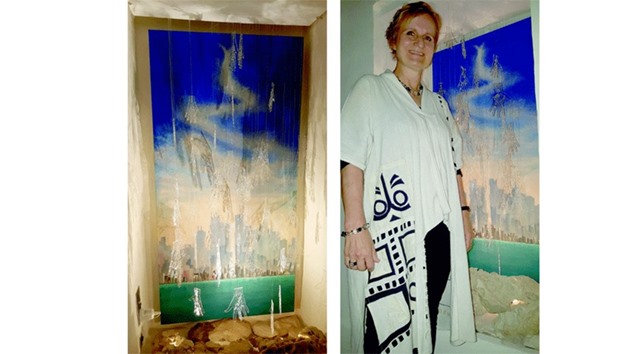Narrating the story of Qatari pioneers who unearthed the future of their country with their hands, she has created a piece of visual beauty and perceptible brilliance.
Phoenix, A Strange Wonder in the Desert by Annette Wendling-Willeke is the story of that then “unknown future” the early pioneers, young Qatari men, found and unearthed hidden under the stones.
Today, this is manifested in a display of unfathomable wealth, iconic buildings and a skyline to behold. The piece exhibited at the recently opened exhibition, Strange Wonders, at the Mushiereb Museums by Virigina Commonwealth University-Qatar (VCU-Qatar), is created by mixing different media.
It has stones collected from the desert, see-through acrylic sheets laser-cut with patterns of tools in the form of henna on them, and canvas.
“The stones are under which the wealth of what we see today was hidden. The early pioneers had to dig it out with these hands, which have been done in traditional henna patterns. And only once the wealth had come up a vision of a city was conceived, which again was built into an actual city by hands,” Annette tells Community in a chat at the opening of the exhibition, standing beside the installation.
“I have mixed different media. In the background is canvas which has image transferred on it and then painted over it. There are see through acrylic sheets used to create hands which alludes to gas and they are hanging on nylon ropes,” she points to the hanging hands, with Doha skyline on canvas in the background, dramatically illuminated.
These hands are see-through because Annette says we do not often think about them who are behind the creation of what we see today as a magnificent skyline.
The title of the exhibition, Strange Wonders, is based on a direct quote from one of the original Qatari oil pioneers, Thamir Muftah. Annette has taken her inspiration for this installation from that quote.
“I wondered how would it have been when they went out there. They saw stones, just stones. They had no idea what will grow out of that one day,” says the artist.
She says it took her a “real long time” to complete it because there were many different processes involved in it. It was designed for the exact space it is fitted in at the venue of the exhibition.
But then when she was working on it, Annette says she had to change a lot of things. Initially, it was meant to be a digital print and photographs, which is not the case with the finished piece. “And this is because the photograph that I wanted to use was not high resolution. So I could not print it in this size to begin. Secondly, the format did not work,” says the artist.
So she recreated her idea with a different photograph, worked with it in Photoshop and then did an image transfer on to the canvas and painted over it.
Annette designed the hands and drew the henna patterns on them. I had to draw them with illustrator, which I am not familiar with. So I had to learn that. And then they were laser-cut and finally the lights were put on, making the contraption to suspend all of these rocks.
Annette has lived and worked as an Interior Architect in Germany, Australia, Sri Lanka and Qatar, and ran her own Interior Design Studio in Sri Lanka, specialising in Residential and Hospitality Projects.
She founded the Interior Design Program at the Academy of Design Colombo, Sri Lanka; held the position of Principal and Interior Design Faculty Head for several years and taught foundation level Drawing and Interior Design Studio classes.
At VCU-Qatar she is programming and co-ordinating all community and outreach classes for high schools, the public, and special needs communities.
In addition to her work related to Outreach and Community at VCU-Qatar, Annette is an active painter, who regularly exhibits her work with International Artists Doha and has also shown work in the VCU-Qatar Faculty and Staff Exhibition and the Annual Friends of the Qatar Fine Arts Society Exhibition.
Her research interest is focused on the continuous change of cultural influence and its impact on art work for artists living between cultures. Annette received a Diplom Ingenieur of Interior Architecture and Furniture Design from the Academy of Fine Arts in Stuttgart, Germany.

There were many processes involved in creating the artwork. Right: Annette Wendling-Willeke says the piece narrates the story of early pioneers of Qatar.


